VOLVO 142, 144, 145 User Manual
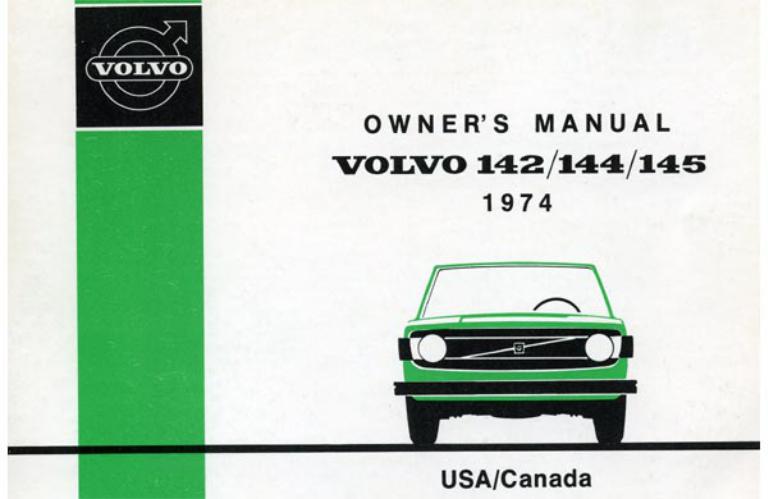
1974 Volvo 142 144 145
1 9 7 4 VOLVO 142 144 145
Notice to Owner: Your Volvo has been built to comply with all American safety and anti-pollution regulations and evidence of this can be verified from the certification label attached on the door opening sheet metal and on the firewall in the engine compartment. For further information regarding these regulations, please talk to your selling dealer.
Volvo 142 144 145
Operating Instructions - Description - Servicing
Before you start driving your new Volvo please read through this manual carefully. It contains all the information you need to be able to drive and service your vehicle in the best possible way. By following the instructions given in this manual you will find that your Volvo will come up to all the expectations concerning economical operation and excellent performance that you have every right to expect of a topquality vehicle.
This is not intended to be a comprehensive technical manual and does not claim to make the reader a perfect car mechanic. It will, however, show you how to look after your vehicle so that trouble in the
http://new.volvocars.com/ownersdocs/1974/1974%20142%20144%20145/74142144145_00.htm (1 sur 4) [2013-03-14 11:43:24]

1974 Volvo 142 144 145
future can be avoided. The better you know your Volvo, the better service it can give you. Even for an experienced motorist it can contain some valuable information.
The specifications and constructional details given in this book are not binding. We reserve the right to carry out modifications without previous notice.
AB VOLVOGOTEBORG, SWEDEN
Reproduction permitted if source is quoted
 pg. 2 Contents
pg. 2 Contents
INTRODUCTION |
|
Volvo Service Organization |
3 |
Warranty and Service Booklet |
3 |
Service Inspections |
3 |
OPERATING INSTRUCTIONS |
|
Instruments and controls |
4 |
Interior and body |
15 |
Starting and driving |
24 |
Running-in |
24 |
Starting the engine |
25 |
Shifting |
26 |
Towing |
29 |
Braking |
30 |
Seat/Ignition Interlock System |
8, 14, 18, 25 |
TECHNICAL DESCRIPTION |
|
Engine compartment |
31 |
Engine |
32 |
Power transmission |
34 |
Front end and steering |
37 |
Heating system |
37 |
Electrical system |
38 |
Brakes |
40 |
SERVICING |
|
General |
41 |
Maintenance schedule |
42 |
Lubrication |
46 |
Oil changes |
47 |
http://new.volvocars.com/ownersdocs/1974/1974%20142%20144%20145/74142144145_00.htm (2 sur 4) [2013-03-14 11:43:24]

50
56
61
61
61
61
63
65
65
84 - 85
67
72
73
74
75
76
76
77
77 CONSUMER INFORMATION 78 - 83 INDEX 86 - 87 WHEN FILLING THE TANK 88
 pg. 3 Introduction
pg. 3 Introduction
Volvo Service Organization
To get the most out of the invested capital represented by a car, it must be looked after and serviced regularly. Volvo has gone to a great deal of trouble in the design and selection of material to ensure that the car in question only requires a minimum of servicing. We rely, however, on your co-operating with regard to the future maintenance of your vehicle. To help you with this, Volvo has built up a world-wide service organization.
All Volvo dealers have specially trained personnel and receive a continuous supply of technical
http://new.volvocars.com/ownersdocs/1974/1974%20142%20144%20145/74142144145_00.htm (3 sur 4) [2013-03-14 11:43:24]

1974 Volvo 142 144 145
information from the Volvo Service Organization concerning repairs and adjustments. They have also special tools, designed at the Volvo factory. Moreover, all Volvo dealers have a comprehensive stock of parts which is a guarantee that the part you get is genuine Volvo. That is why our dealers are in the best possible position to give your vehicle first-class service concerning both maintenance operations and repairs.
You should also refer to your dealer for any information about your Volvo that is not included in this manual.
Not only has Volvo a workshop within call in your own country, it also has a widely distributed service network in other countries.
Warranty and Service Booklet
A warranty and service booklet accompanies each vehicle when it is delivered. This booklet contains a coupon entitling you to a service inspection after 1,500 miles (2,500 km). If possible, let the dealer who supplied the vehicle make this service inspection. Any of our dealers, however, can do this if required. If our guarantee is to apply, we make one absolute condition and that is that the above-mentioned inspection is made at roughly the mileage shown and that the vehicle has been looked after in accordance with the instructions given in this manual.
Service Maintenance
After the 1,500 miles (2,500 km) service inspection has been made, you should come to some arrangement with your dealer concerning continued, regular service maintenance in accordance with the suggestions made in our Service Book. Thorough and regular servicing is of vital importance for the performance and length of life of the vehicle.
Always use genuine Volvo parts.
Top of Page
http://new.volvocars.com/ownersdocs/1974/1974%20142%20144%20145/74142144145_00.htm (4 sur 4) [2013-03-14 11:43:24]
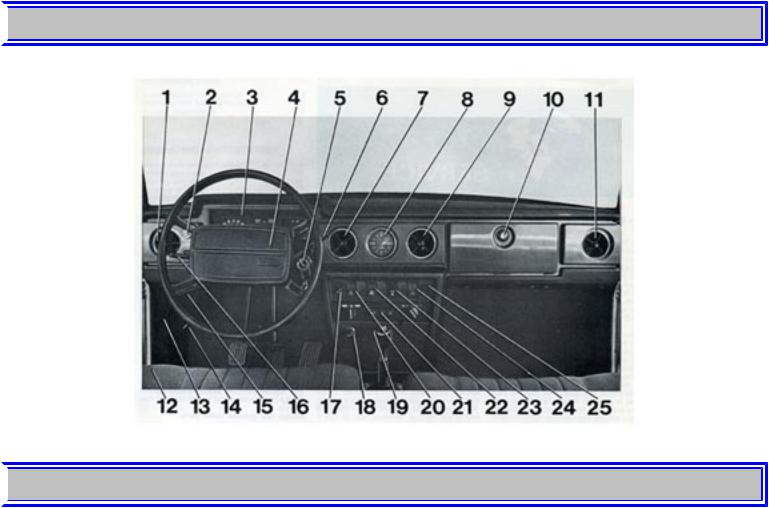
1974 Volvo 142 144 145
1 9 7 4 VOLVO 142 144 145
 pg. 4 OPERATING INSTRUCTIONS
pg. 4 OPERATING INSTRUCTIONS
 pg. 5 OPERATING INSTRUCTIONS
pg. 5 OPERATING INSTRUCTIONS
INSTRUMENTS AND CONTROLS
1.Air vent
2.Headlight switch
3.Combined instrument
4.Horn
5.Ignition switch and steering wheel lock
6.Windshield wiper/washer control lever
7.Air vent
8.Clock
9.Air vent
10.Glove locker
11.Air vent
12.Parking brake
13.Fuse box (fuse replacement, see page 60)
http://new.volvocars.com/ownersdocs/1974/1974%20142%20144%20145/74142144145_01.htm (1 sur 32) [2013-03-14 11:43:46]
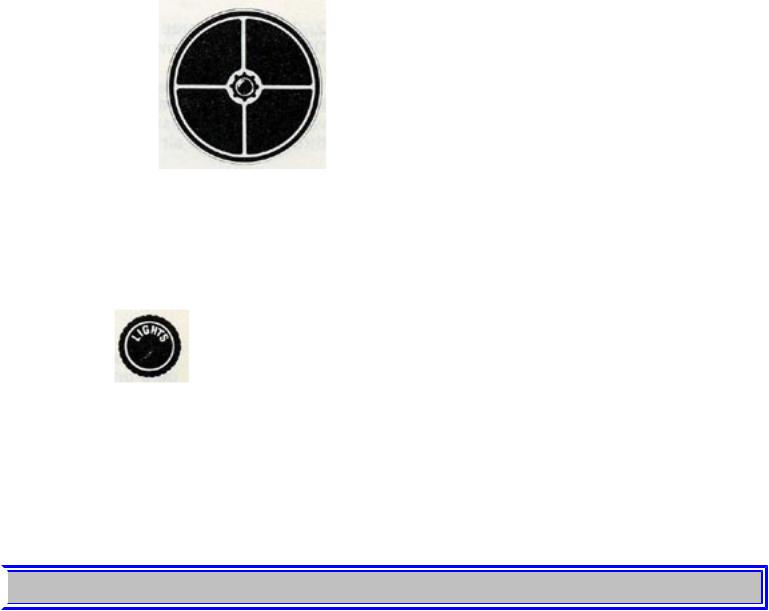
1974 Volvo 142 144 145
14.Fresh-air intake vent
15.Hood release handle
16.Turn signal, switch lever, dimmer and headlight flasher
17.Rheostat for instrument panel lighting
18.Cigarette lighter
19.Ash tray
20.Switch for tailgate window wiper/washer (145)
21.Heater and ventilation controls
22.Switch, electrically heated rear window
23.Switch, emergency warning flashers
24.Fan switch
25.Seat belt reminder light
The instruments and controls are described in more detail in the following pages with a reference to the numbers in the picture above.
1, 7, 9, 11 Air vents
Air is supplied to the compartment by means of the four air vents. Air is blown through these vents by the blower fan which is operated by switch (see page 12). The vents can be shut off completely by turning the button in the center of each vent a 1/4 turn anti-clockwise. The vents can also be adjusted to point to any particular place in the compartment. The two outer vents can even be used for demisting the front door windows.
2 Light switch
The headlights are operated by a push-pull type switch on the dash-board as well as a lever (16) on the steering column.
All the lights are extinguished when the light switch is pushed fully in. Pulling it out to the half-way position, switches on the parking lights, and when it is fully out, the upper or lower beams are switched on, depending on the position of the lever (16).
Since the lighting system is not connected across the ignition switch, the lights will function irrespective of whether the ignition key is in position or not.
 pg. 6 OPERATING INSTRUCTIONS
pg. 6 OPERATING INSTRUCTIONS
http://new.volvocars.com/ownersdocs/1974/1974%20142%20144%20145/74142144145_01.htm (2 sur 32) [2013-03-14 11:43:46]
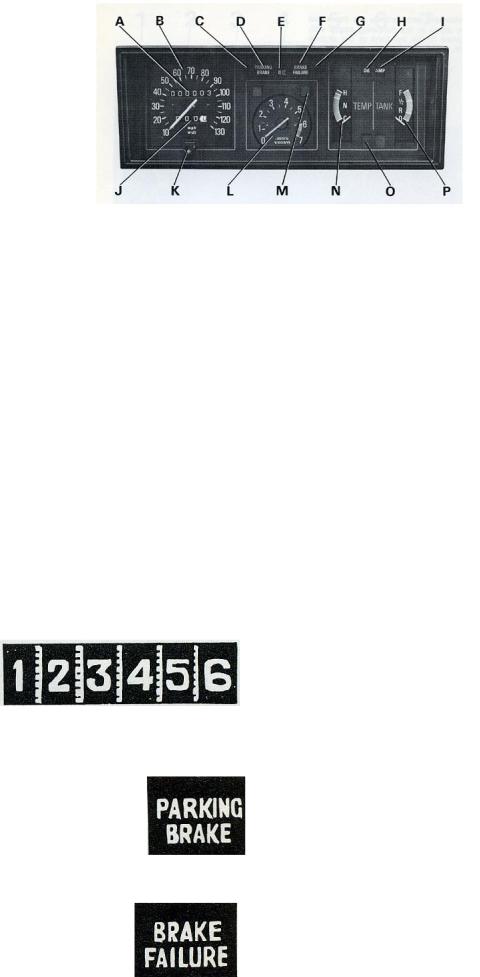
1974 Volvo 142 144 145
3 Combined Instrument
AOdometer
BSpeedometer
CLeft turn indicator light (green)
DParking brake warning light (red)
EUpper beam control light (blue)
FBrake circuit warning light (red)
GRight turn indicator light (green)
HOil pressure warning light (red)
IBattery charge warning light (red)
JTrip odometer
KTrip odometer reset knob
LTachometer
MBulb Integrity Sensor warning light (yellow)
NTemperature gauge
0 Overdrive control light (green) P Fuel gauge
A Odometer
The odometer shows the total distance covered in miles. After 999999 miles it returns to zero and starts to go round again.
D Parking brake warning light
This light gives a steady, red light when the ignition is on and the parking brake applied.
F Brake circuit warning light
This light gives a steady red light should a failure arise in one of the brake circuits. If the light goes on during driving, the car should be driven to a workshop to check the brake system.
http://new.volvocars.com/ownersdocs/1974/1974%20142%20144%20145/74142144145_01.htm (3 sur 32) [2013-03-14 11:43:46]
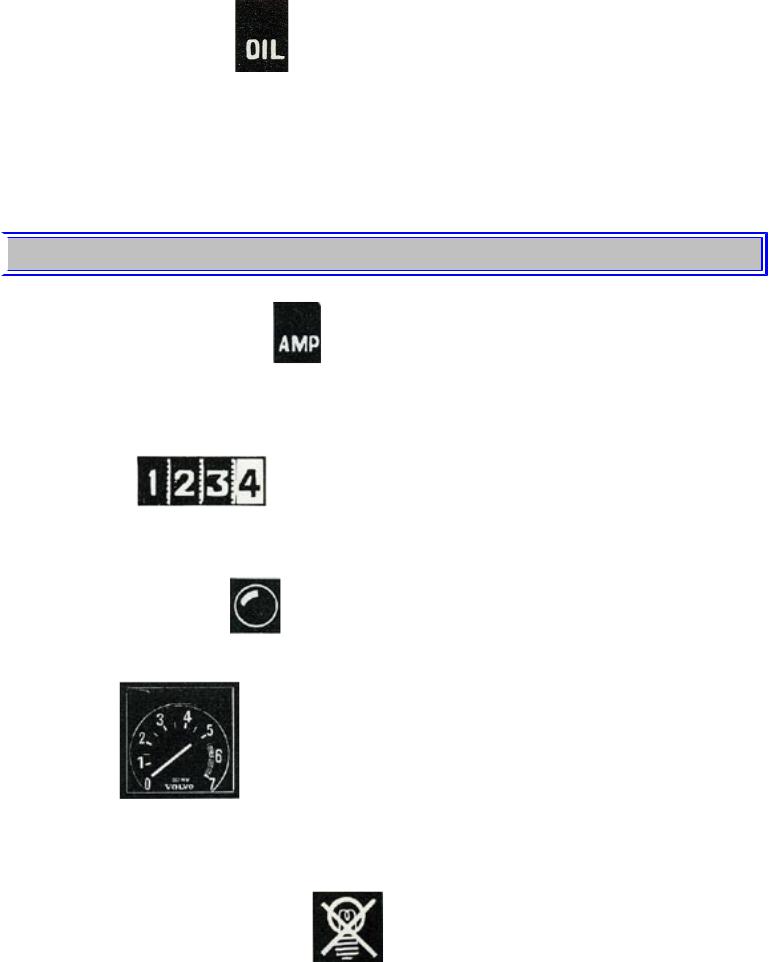
1974 Volvo 142 144 145
Observe due care when driving under these conditions.
H Oil pressure warning light
This lights red when the engine oil pressure is too low. When the ignition is switched on, the light should go on and then go out again when the engine starts. Never start driving until the light goes out. If the light goes on during driving, stop the engine and find out the reason for this. In most cases it means that the oil level is too low. After hard driving it may happen that the warning light comes on when the engine is idling. This is normal providing it goes out again when engine speed is increased.
 pg. 7 OPERATING INSTRUCTIONS
pg. 7 OPERATING INSTRUCTIONS
I Warning light, battery charging
This lights red when the battery is discharging. Should it light during driving, either there is some fault in the electrical system or the fan belt is not sufficiently tensioned and is thus slipping on the alternator pulley, causing poor charging.
J Trip odometer
The trip odometer measures distances of up to maximum 999 miles. The window furthest to the right shows tenths of a mile and is therefore useful for measuring short distances.
K Trip odometer reset knob
The trip odometer is reset to zero by pushing in the knob.
L Tachometer
The tachometer shows the engine rpm in thousands per minute. The area marked in orange color between 6000 rpm and 6500 rpm indicates rpm-ranges momentarily permitted and may be used for instance during fast acceleration. The rpm-area 6500 - 7000 rpm is marked red and must not be used.
M Bulb Integrity Sensor warning light
The light gives a steady yellow light should any of the bulbs for lower beam, tail light or license light
http://new.volvocars.com/ownersdocs/1974/1974%20142%20144%20145/74142144145_01.htm (4 sur 32) [2013-03-14 11:43:46]
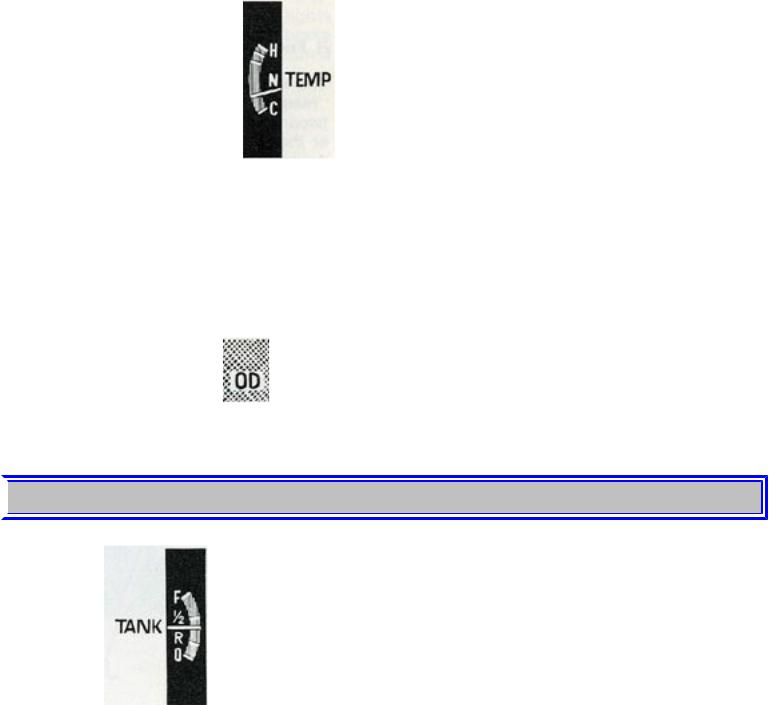
1974 Volvo 142 144 145
(not Volvo 145) go out. If any one of the stop lights is out, the warning light comes on when the brake pedal is applied.
The light comes on when the ignition is switched on and goes out when the engine starts.
N Coolant temperature gauge
The temperature gauge shows the temperature of the coolant and thus indicates the working temperature of the engine. The gauge pointer should normally remain within the green sector. During town driving and idling when the weather is particularly warm, the temperature gauge pointer may enter the amber field.
Should the pointer repeatedly point to the solid red field, coolant and fan belt tension should be checked.
0 Warning lamp, overdrive
The lamp gives a steady green light when the overdrive is engaged. Concerning engaging and disengaging overdrive, see page 26.
 pg. 8 OPERATING INSTRUCTIONS
pg. 8 OPERATING INSTRUCTIONS
P Fuel gauge
The fuel gauge is graduated "full", "half", "reserve", and "empty". The red field between "reserve" and "empty" is a reminder that the tank should be filled. When the gauge pointer is on "reserve", there are approx. 2 1/2 US galls/2 Imp. galls (8 liters) in the tank. The gauge pointer registers when the ignition is switched on.
4 Horn
The horn blows when the pad in the center of the steering wheel is pushed in and the ignition has been switched on.
http://new.volvocars.com/ownersdocs/1974/1974%20142%20144%20145/74142144145_01.htm (5 sur 32) [2013-03-14 11:43:46]

1974 Volvo 142 144 145
5 Combined ignition switch and steering wheel lock
The switch has four positions: (0) Locking, (1) Intermediate, (2) Driving and (3) Starting. The key can be taken out of the lock only in the Locking position.
On the rear cover inside page you will find space for noting the number of the door key and the ignition key. If a key gets lost, contact your nearest Volvo dealer for new ones and indicate the number of the lost key.
The ignition switch is provided with a buzzer to remind the driver should he forget to remove the ignition key when his door is opened.
Removing the key automatically locks the steering wheel.
With the key in the Intermediate position, the steering wheel is not locked and some electrical components are switched on.
To start the engine, turn the key to the Starting position. This engages the starter motor. As soon as the engine starts, release the key which automatically returns to the Driving position.
Note: If this vehicle is equipped with an ignition interlock system as required by US safety standards, the engine cannot be started unless the driver and front seat passenger have fastened their seat belts. Because of a special sequencing circuit in the belt interlock control, the seat belts must be fastened after the occupant is seated and before the key is turned to the starting position. If the proper sequence is not followed, the seat belt reminder light and buzzer are actuated and the engine will not start (see Engine Starting Instructions on page 25).
If the car is parked in such a way as to make it difficult to unlock the steering wheel, unlocking can be made easier by slightly turning the steering wheel one way and then the other.
When the ignition is switched on, but before the engine has started, the following lights will be on:
●Oil pressure warning light
●Battery charge warning light
●Bulb Integrity Sensor warning light
●Parking brake warning light
●Brake circuit warning light
This is an indication that the lights function. When the engine has started, all lights should be out (except the Parking brake warning light if the parking brake should be applied).
 pg. 9 OPERATING INSTRUCTIONS
pg. 9 OPERATING INSTRUCTIONS
http://new.volvocars.com/ownersdocs/1974/1974%20142%20144%20145/74142144145_01.htm (6 sur 32) [2013-03-14 11:43:46]
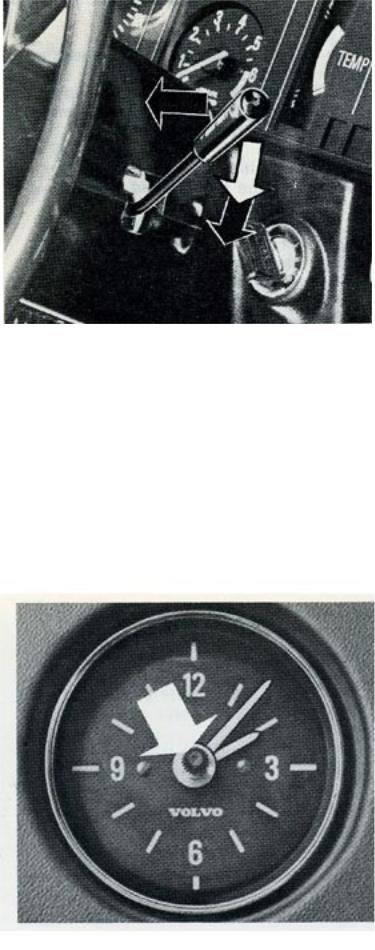
1974 Volvo 142 144 145
6 Windshield wiper/washer control lever
The windshield wipers have two speeds. Moving the lever downwards one stage operates the wipers at normal speed. This speed is recommended for normal driving in rain or snow. Pushing the lever down fully operates the wipers at full speed. This is recommended only when driving in heavy rain or when driving at high speed in the rain.
The windshield washer is switched on by moving the control laver towards the steering wheel. The washer can be used even when the wipers are not switched on.
The washer container is located in the engine compartment and holds about 1.3 US gallons = 1.1 Imp. gallon = 5 liters.
8 Clock
The clock is operated electrically. To reset it, push in the re-setting knob and turn the hands.
http://new.volvocars.com/ownersdocs/1974/1974%20142%20144%20145/74142144145_01.htm (7 sur 32) [2013-03-14 11:43:46]
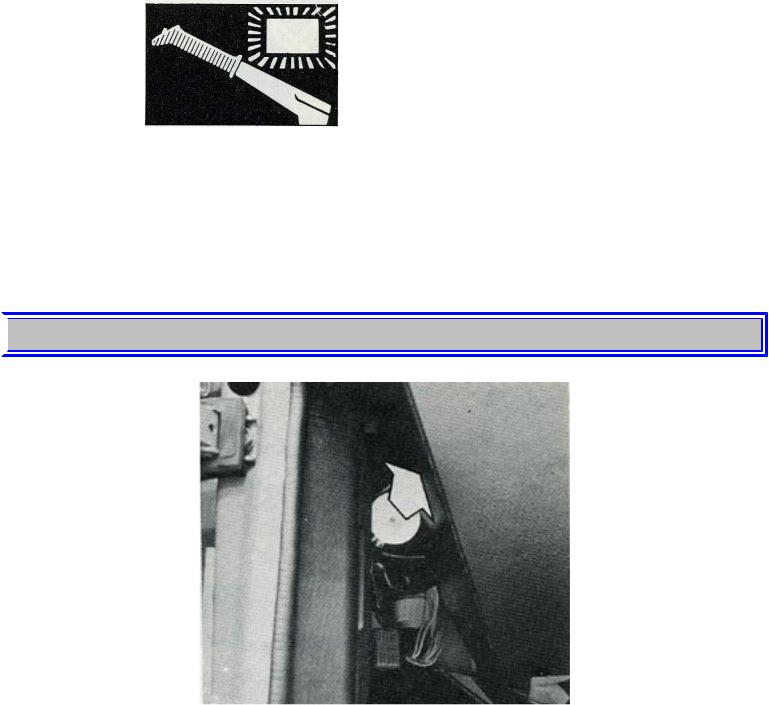
1974 Volvo 142 144 145
12 Parking brake
The parking brake lever is on the outside of the driver's seat and operates on the rear wheels only. When the parking brake is applied and the ignition is on, a red warning light (3, D) shows on the instrument panel.
14 Fresh-air control
Pushing the control forwards opens fresh air intake vents on the left side. Note that the fan should not be operating if cool air is desired through this vent.
 pg. 10 OPERATING INSTRUCTIONS
pg. 10 OPERATING INSTRUCTIONS
15 Hood release handle
The hood is released by pulling out the handle situated to the extreme left under the dash. This releases the hood which is still held by the safety latch.
http://new.volvocars.com/ownersdocs/1974/1974%20142%20144%20145/74142144145_01.htm (8 sur 32) [2013-03-14 11:43:46]
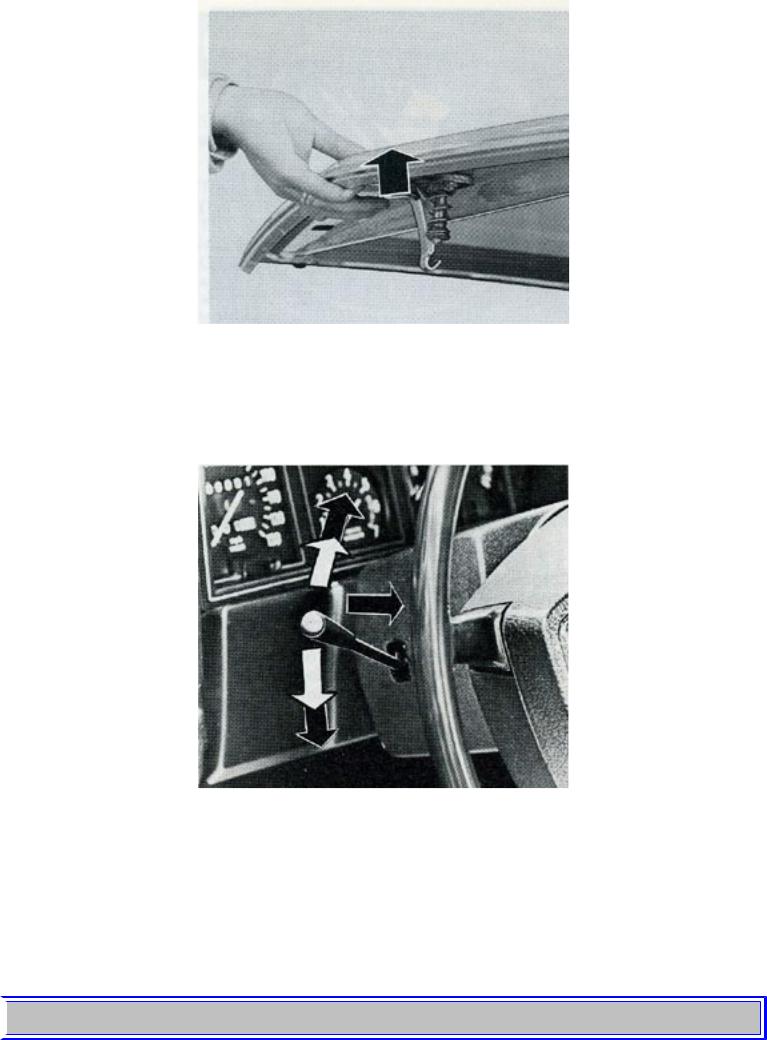
1974 Volvo 142 144 145
The hood is opened by inserting the fingers under the front edge and pressing in the catch.
Check that it shuts properly when closed. The location of the hood when closed can be adjusted if necessary by screwing in or out the rubber plugs underneath the hood at the front end and on the mudguards below the windshield.
16 Turn signal lever, dimmer and headlight flasher
The lever on the left-hand side of the steering column just below the steering wheel controls turn signals, headlights and headlight flasher. The lever has a stop point for lane changing. This means that with small swings on the steering wheel (when, e.g., changing lanes, passing, etc.) the lever can be moved up or down to this point and kept there. The right or left signal will then start flashing. When the switch lever is released, it automatically returns to its off position. For normal swings on the steering wheel, the lever is moved past this stop point to the end position.
 pg. 11 OPERATING INSTRUCTIONS
pg. 11 OPERATING INSTRUCTIONS
http://new.volvocars.com/ownersdocs/1974/1974%20142%20144%20145/74142144145_01.htm (9 sur 32) [2013-03-14 11:43:46]

1974 Volvo 142 144 145
Straightening up the steering wheel will return the lever to its off position. Switching from upper beams to lower beams and vice versa is made by moving the lever towards the steering wheel and then releasing it. Here the lighting switch (2) should be pulled fully out.
The lever is also used for flashing with upper beams when the headlights are not switched on. The headlight flasher is switched on by moving the lever towards the steering wheel and it remains switched on until the lever is released.
17 Rheostat for instrument panel light
Rotate knob clockwise to turn on panel light and counterclockwise to dim it.
18 Cigarette lighter
To use the cigarette lighter, push it in. The lighter releases automatically when it attains sufficient heat.
19 Ash tray
To empty the ash tray, pull it straight out all the way while pressing down the tongue inside.
20 Tailgate window wiper/washer switch (145 Station Wagon)
The switch for the tailgate window wiper/washer is in the form of a tangent. At the first notch, both wiper and washer are engaged. To keep both operating, the switch must be held in position by the hand.
Pushing the lower part of the switch in fully operates only the wiper. It is stopped by pushing in fully the upper part of the hand. The fluid container for the washer is placed in the cargo space at the very back, to the right, and holds about 3 1/4 US pints, 2 3/4 Imp. pints (1 1/2 liters).
 pg. 12 OPERATING INSTRUCTIONS
pg. 12 OPERATING INSTRUCTIONS
21 Heater/ventilation controls
The heating system is a combined warm air and fresh air system, available with or without air conditioner.
The system comprises the following controls:
1.TEMP (temperature)
2.FLOOR (floor)
http://new.volvocars.com/ownersdocs/1974/1974%20142%20144%20145/74142144145_01.htm (10 sur 32) [2013-03-14 11:43:46]
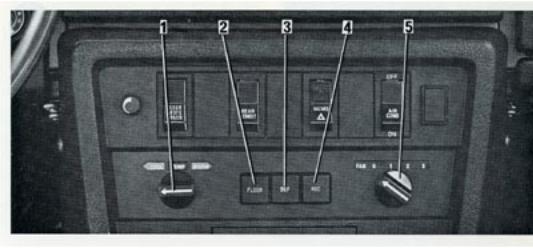
1974 Volvo 142 144 145
3.DEF (defroster)
4.REC (recirculation)
5.FAN (fan)
and partly also the four air vents, see page 5.
1. TEMP controls the incoming air temperature. Counter-clockwise = COOL.
Clockwise = WARM.
2, 3, 4. The three push buttons FLOOR, DEF and REC provide well-balanced standard settings.
No buttons pushed In: No air to floor and very little to defroster. Air can be obtained through the four air vents.
Only FLOOR pushed in: Full air flow to front and rear floor, very little to defroster.
Only DEF pushed in: Full defroster, no air to floor.
Push button REC is intended to be used in combination with air conditioner (extra equipment) and should not be used for heating.
5. FAN controls the fan speed.
0 = Off.
3 = Full speed (mainly intended for air conditioner).
In order to obtain high temperature fast, adjust:
TEMP fully clockwise.
FAN position 2 (use pos. 3 in extreme cases, only).
FLOOR pressed in, only.
Air vents half way open.
This adjustment reduces the defroster efficiency.
http://new.volvocars.com/ownersdocs/1974/1974%20142%20144%20145/74142144145_01.htm (11 sur 32) [2013-03-14 11:43:46]
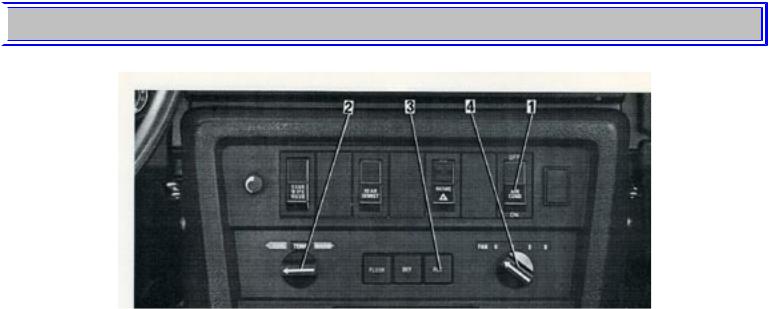
1974 Volvo 142 144 145
If you want to avoid or rapidly remove mist inside the windows, adjust: TEMP fully clockwise
FAN position 2 (use pos. 3 in extreme cases only) DEF pushed in, only
The outer air vents half way open.
When starting a snow-covered car, any snow covering the heater air intakes should be removed to avoid misting.
 pg. 13 OPERATING INSTRUCTIONS
pg. 13 OPERATING INSTRUCTIONS
Air conditioner (optional)
1.Switch on the compressor with AIR COND.
2.Turn control TEMP to COOL( fully counter-clockwise) for rapid cooling. Thereafter, choose desired temperature.
3.Push in button REC for rapid cooling. When desired temperature has been obtained, the button may be pulled out again.
4.Select suitable fan speed with control FAN.
The best cooling effect is reached by keeping all windows closed and none of the buttons FLOOR or DEF pushed in.
Most of the cooled air will then enter the four dash air vents which should be fully open.
A good tip: For rapid removal of mist, the air conditioner can be switched on also at temperatures when it normally not should be used.
1.AIR COND pushed in.
2.REC pushed in.
3.FAN position 2 (use pos. 3 in extreme cases only).
http://new.volvocars.com/ownersdocs/1974/1974%20142%20144%20145/74142144145_01.htm (12 sur 32) [2013-03-14 11:43:46]
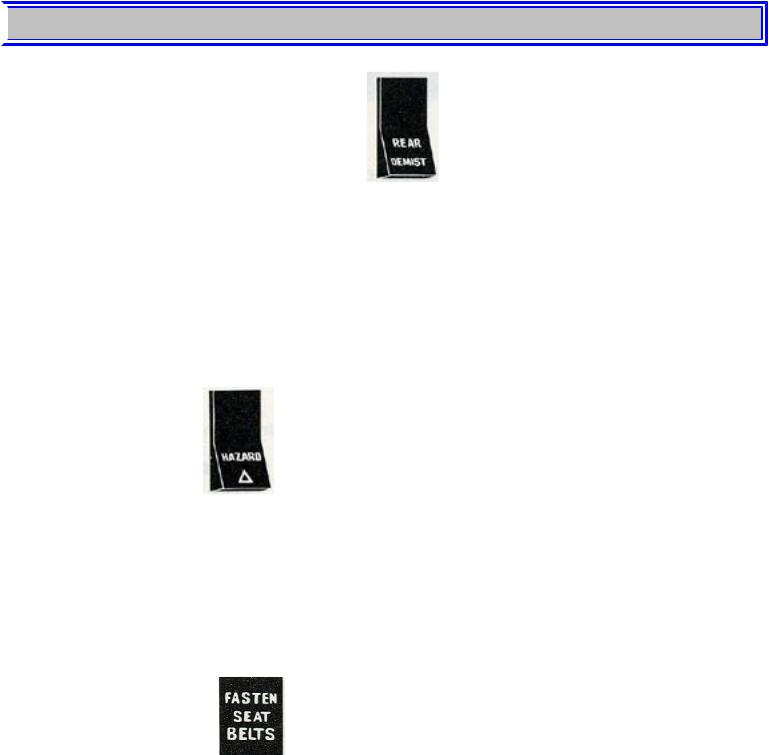
1974 Volvo 142 144 145
4. TEMP regulated to desired temperature.
Run the air conditioner a few times every month, also in wintertime when it is not used, in order to lubricate the compressor seals.
Check the air conditioner yearly at a Volvo shop.
 pg. 14 OPERATING INSTRUCTIONS
pg. 14 OPERATING INSTRUCTIONS
22 Switch for electrically heated rear window
In order to obtain a clear rear view during cold and damp weather, the car is equipped with an electrically heated rear window. Heating is provided by wires on the inside of the rear window. Avoid placing anything near the wires that might damage them. Observe due care when cleaning the window inside, as rings etc may damage the wires.
The heating is switched on by pushing in the lower part of the switch. This lights up a warning lamp mounted in the switch. Pushing in the upper part of the switch switches off the heating.
Switch off the heating when the rear window is clear of mist and ice in order not to overload the battery unduly.
23 Switch for emergency
All four emergency warning lights start flashing when the lower part of the switch is pushed in. A warning lamp in the switch blinks in union with them. This warning light is not wired across the ignition and therefore functions irrespective of whether the ignition is switched on or not. Pushing in the switch again puts out the flasher lights.
The emergency warning lights should only be used when the car must be stopped where there is danger to other traffic. Note that regulations concerning the use of these lights may vary from place to place.
25 Seat belt reminder light
If either front seatbelt is unfastened after the engine has been started with the gear selector in any forward gear, the seat belt reminder light and buzzer will actuate.
Note: If this vehicle is equipped with an ignition interlock system and the ignition key is turned to the starting position without first fastening the front seat belts, the seat belt reminder light and buzzer will actuate and the starter will not engage. Should the light and buzzer actuate while the engine is running, even though the seat belts are fastened, it is an indication that the belt interlock control is out
http://new.volvocars.com/ownersdocs/1974/1974%20142%20144%20145/74142144145_01.htm (13 sur 32) [2013-03-14 11:43:46]
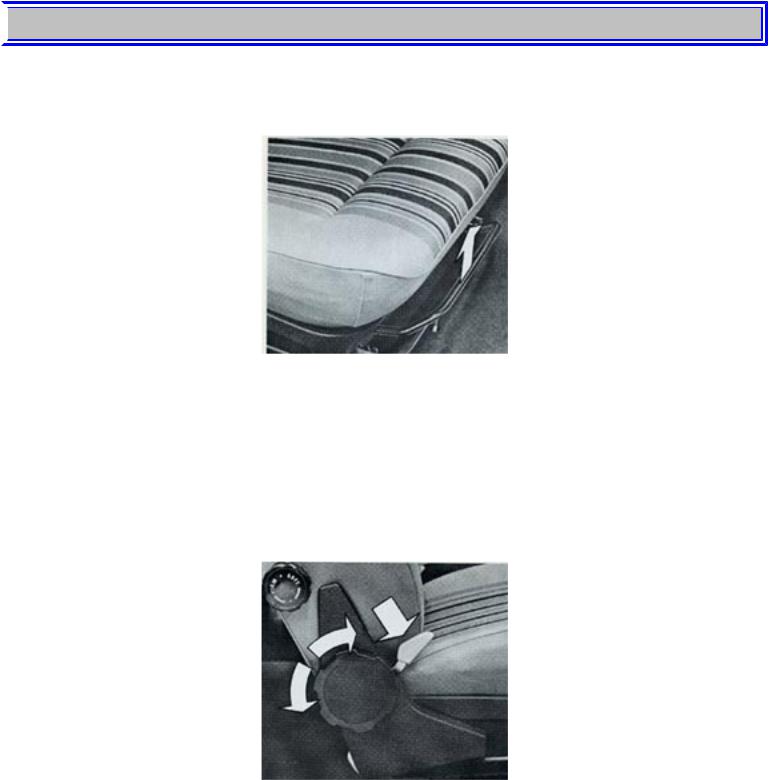
1974 Volvo 142 144 145
of sequence, and the starter will not engage should the engine stop. In this case, release and refasten the front seat belts at each occupied position which should turn off the reminder light and buzzer.
 pg. 15 OPERATING INSTRUCTIONS
pg. 15 OPERATING INSTRUCTIONS
INTERIOR AND BODY
Front seats
The front seats can be moved forwards and backwards after the loop handle on the seat front has been pulled upwards. Exert leverage with your feet on the floor and slide the seat to position desired.
The seat back inclination is invariably adjustable by a hand wheel.
Certain models have electrically heated seat cushions and seat backs. The seat cushion is provided with a thermostat which cuts in when the cushion temperature is below +14°C = 57°F and cuts out at +26°C = 78°F. The heater pad is energized only when the ignition is on.
Seat back latches
The front seat back in the Volvo 142 model is latched against forward tilting. To fold the seat back forwards, the latch device must be released by pressing down the lever as shown in the picture.
http://new.volvocars.com/ownersdocs/1974/1974%20142%20144%20145/74142144145_01.htm (14 sur 32) [2013-03-14 11:43:46]
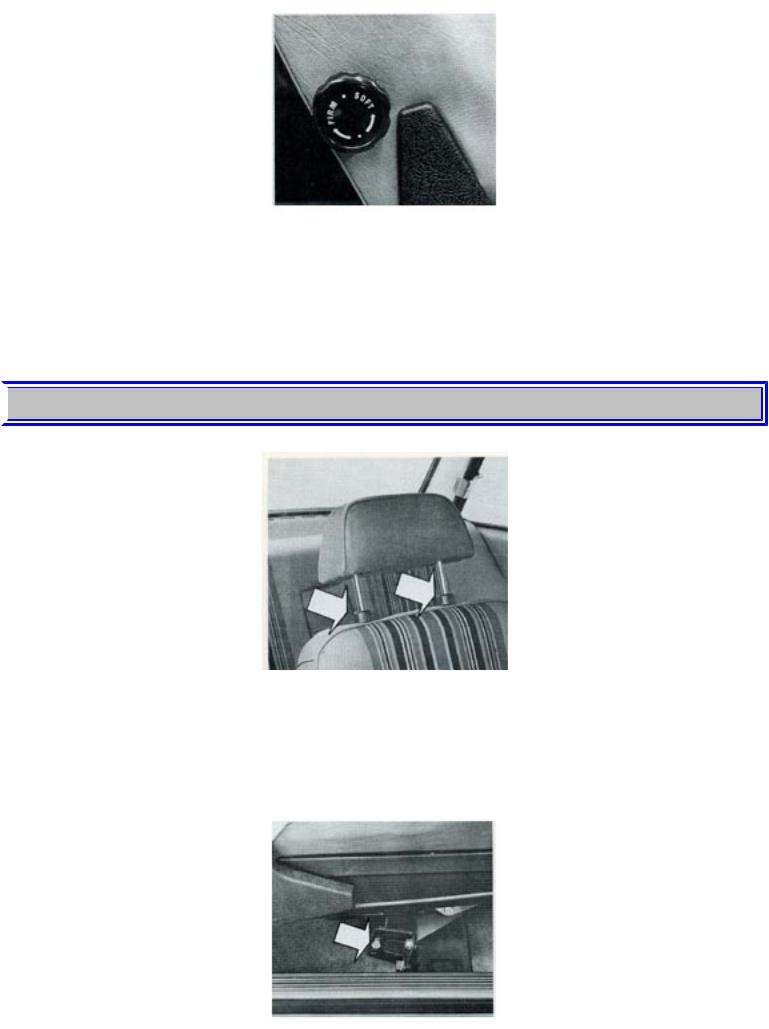
1974 Volvo 142 144 145
Lumbar support
The front seats are provided with an adjustable lumbar support. Adjustment is by means of the knob on the backrest. To tension the lumbar support, and thus exert more pressure against the small of the back, turn the knob clockwise "FIRM", and to relieve the pressure against the small of the back, turn the knob anti-clockwise "SOFT".
 pg. 16 OPERATING INSTRUCTIONS
pg. 16 OPERATING INSTRUCTIONS
Head restraints
The front seats are equipped with adjustable head restraints. Before driving, you should always make sure that the head restraints is adjusted to your height. Adjust by slackening the plastic nuts on the head restraints retainers, see picture. After adjustment, lock by turning the plastic nuts clockwise.
http://new.volvocars.com/ownersdocs/1974/1974%20142%20144%20145/74142144145_01.htm (15 sur 32) [2013-03-14 11:43:46]
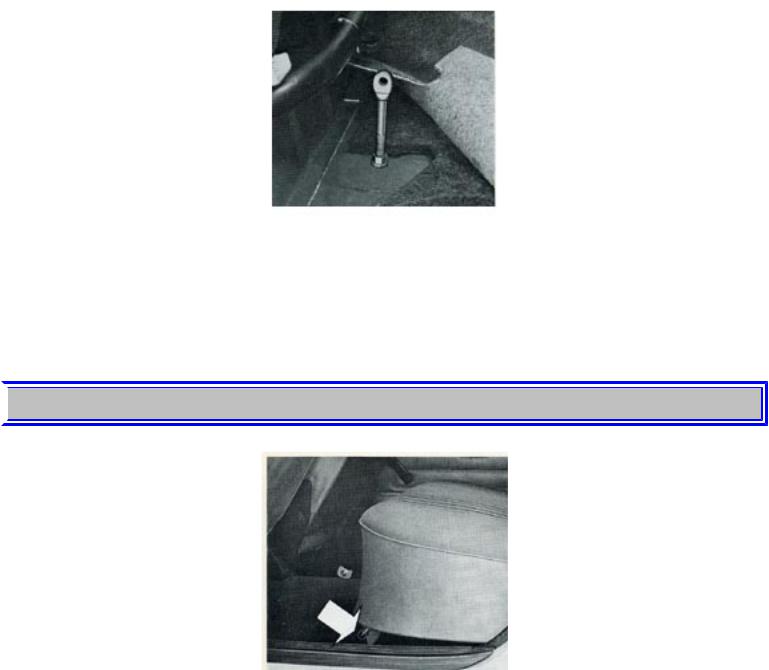
1974 Volvo 142 144 145
Adjustment
The seat level can be adjusted to three different positions. To do this, remove the seat cushion in order to reach the bolts in the seat bracket. Remove the two bolts attaching the frame to the seat bracket. Set the seat to the desired position and fit the bolts into the holes which are at the same height on both sides.
When this adjustment is being made it may also be desirable or necessary to adjust the entire inclination angle of the seat. This is done with the eyelet screw at the front under the seat frame. Remove the bolt which goes through the eyelet and tilt the seat backwards. Then slacken the lock nut on the floor and adjust the eyelet screw to the desired height. Re-install the bolt and secure the eyelet screw with the lock nut.
 pg. 17 OPERATING INSTRUCTIONS
pg. 17 OPERATING INSTRUCTIONS
Rear seat 145 Station Wagon
The rear seat back can be folded if extra cargo space is required. This is done as follows:
1 Push down one of the levers at the seat cushion front (rear or left side) and lift at the same time up the cushion towards the front seat backs.
http://new.volvocars.com/ownersdocs/1974/1974%20142%20144%20145/74142144145_01.htm (16 sur 32) [2013-03-14 11:43:46]
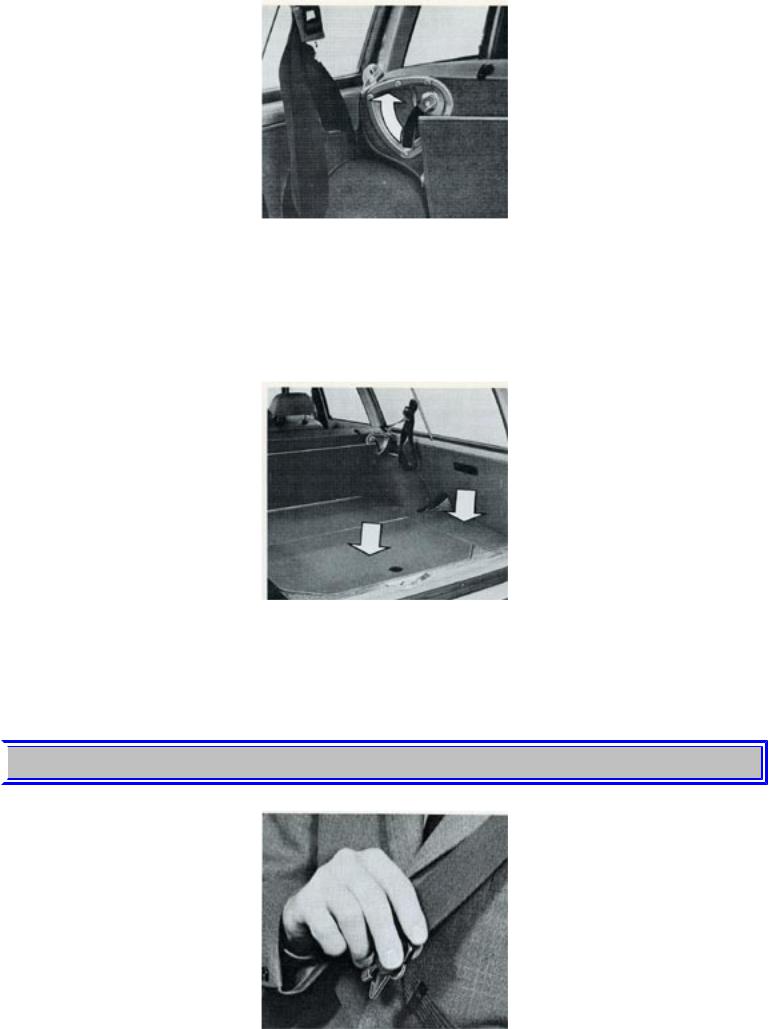
1974 Volvo 142 144 145
2 Move up one of the parallel-connected handles on the rear side of the seat back and fold the seat back forward - downwards so that it lies flat. The rear seat back and seat are fixed automatically in their respective positions. When folding up the seat back again, make sure that the latches grip properly in their fittings. Make sure that the seat belts are on the top side of the seat cushion before it is put back in its original position.
Extra storage space 145 Station Wagon
Underneath the floor of the cargo compartment there is extra storage space, which is accessible by removing its cover. The tool set is located in this space.
The container for the rear window washer is located in the spare space all the way to the rear.
 pg. 18 OPERATING INSTRUCTIONS
pg. 18 OPERATING INSTRUCTIONS
http://new.volvocars.com/ownersdocs/1974/1974%20142%20144%20145/74142144145_01.htm (17 sur 32) [2013-03-14 11:43:46]
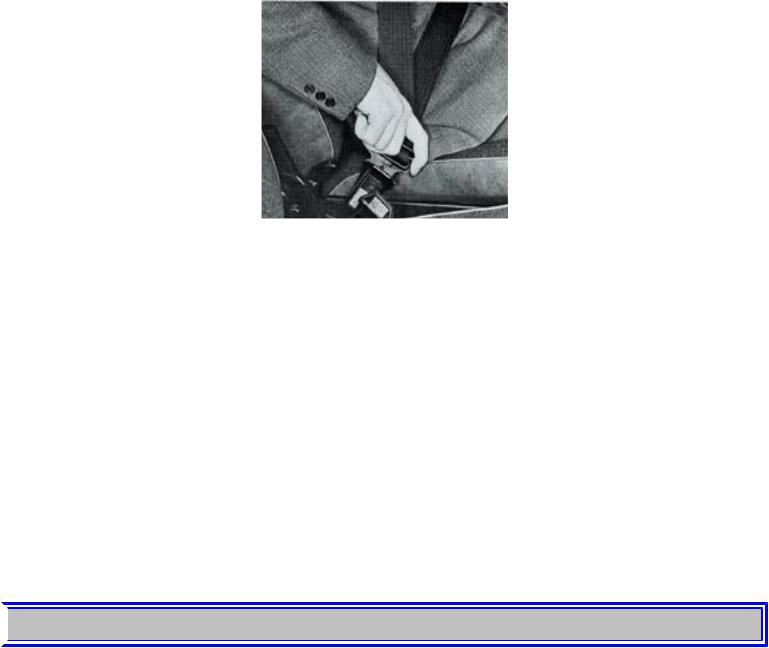
1974 Volvo 142 144 145
Seat belts
Always use the seat belt for all types of driving. Remember that it is possible even in slow city traffic to incur serious injury from sudden, unexpected stopping.
Note: If this vehicle is equipped with an Ignition Interlock System as required by U.S. Safety Standards, the engine cannot be started unless the driver and front seat passenger have fastened their seat belts. The seat belts must be fastened after the occupant is seated and before the key is turned to the starting position (see engine starting Instructions on page 25).
There is a buzzer and a warning light on the instrument panel which both remind the driver that the seat belts have to be fastened. See page 14.
Your car is equipped with automatically retracting inertia seat belts.
To fasten the belt, pull out the strap slowly (with right hand for belt on left hand side, with left hand for belt on right hand side) to prevent the mechanism from locking. Normally the belt roller is "unlocked". The roller will lock automatically if pulled out quickly, or if the car brakes or inclines to an angle greater than 10-15° or when taking a bend rather sharply.
The practical design of the belt makes it very easy to use. Place the belt with one strap over the lap and the other across the shoulder-chest and fasten it by pushing the buckle tongue into the slot of the locking device located between the front seats. A clearly audible clicking sound indicates that the belt is locked. Make sure that those parts of the belt against the body are not twisted.
The belt is released from the lock by pushing in the square red button on the lock. Always make a habit of letting the belt roller pull in the belt strap when the belt is unfastened.
If the belts do not retract fully, this may be due to the fact that they are twisted inside their casing. This is remedied by pulling out the belt fully and then allowing it to be drawn into the casing.
Note that small children (up to the age of 8-10 years) should not use the seat belts.
 pg. 19 OPERATING INSTRUCTIONS
pg. 19 OPERATING INSTRUCTIONS
Seat belts in rear seat
The seat belts at both sides of the rear seat are also of the automatic retracting type. When fastening these belts pull them out rather slowly to prevent them from locking before being fastened. These belts are fastened by pushing the tongue at the end of one strap into the lock on the other. To unfasten
http://new.volvocars.com/ownersdocs/1974/1974%20142%20144%20145/74142144145_01.htm (18 sur 32) [2013-03-14 11:43:46]
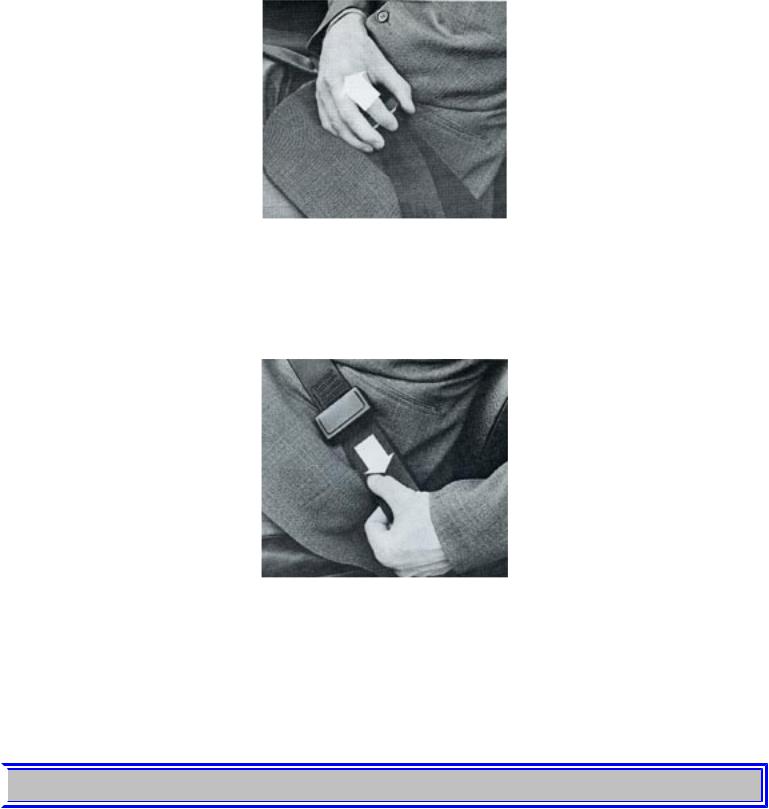
1974 Volvo 142 144 145
just press in the square red button.
The belt in the middle of the rear seat is manually adjusted. It is fastened and unfastened in the same way as the side belts in the rear seat.
To lengthen the center belt, turn the buckle and pull it out as shown in the picture. To shorten the belt pull the upper belt strap.
Hang up the seat belt on its place when it is not in use.
Check now and then that the bolts are secure and the belt in good condition. Use water and a detergent for cleaning.
As the seat belts lose much of their strength when exposed to violent stretching, they should be replaced after collision, even though they may appear to be undamaged.
Never modify or repair the belt on your own, but have this done by a Volvo workshop.
 pg. 20 OPERATING INSTRUCTIONS
pg. 20 OPERATING INSTRUCTIONS
http://new.volvocars.com/ownersdocs/1974/1974%20142%20144%20145/74142144145_01.htm (19 sur 32) [2013-03-14 11:43:46]
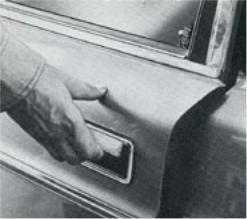
1974 Volvo 142 144 145
Doors and locks
The car is equipped with a lock and keyhole on each of the front doors.
The front doors can be locked from the outside by pressing the lock button on the window ledge down and shutting the door while holding the outside handle pulled out as shown in the picture.
To lock the rear doors, push down the inside lock button. It is not necessary to keep the outside handle pulled out.
Do not leave the keys in the car.
All the doors can be locked on the inside by pressing down the lock button on the window ledge. On the front doors this lock button lifts automatically when the door is opened from the inside. On the rear doors, however, the lock button must first be pulled up before the doors can be opened from the inside.
Note that the front doors are not better closed if the lock buttons are pressed down since this only prevents the door from being opened from the outside.
During driving the lock buttons should not be pushed down as this would only prevent anyone from opening the door on the outside should an accident occur.
The door locks have been designed to provide maximum possible protection against freezing during the wintertime. As an extra measure, however, you should lubricate the locks regularly during very cold weather with a suitable antifreeze agent. If the lock is already frozen, be careful not to break the key in the lock. Instead, heat the key and immediately place it in the lock. This should unfreeze the lock. Should you lose the car keys, contact your nearest Volvo dealer for new ones and quote the code number of the keys which have been lost.
http://new.volvocars.com/ownersdocs/1974/1974%20142%20144%20145/74142144145_01.htm (20 sur 32) [2013-03-14 11:43:46]
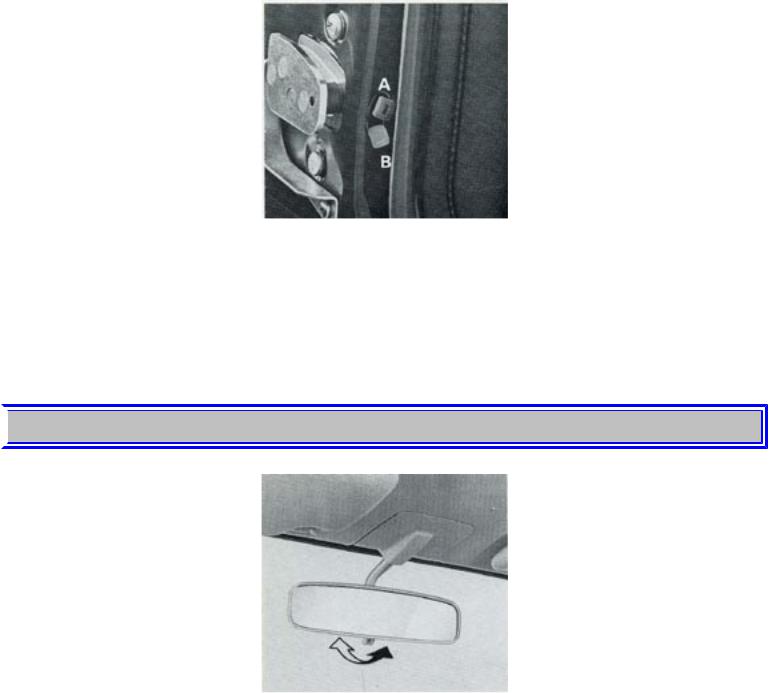
1974 Volvo 142 144 145
Child safety lock
On the Volvo 144 and 145 there is a small red button located at the very back on the inside of the rear doors. Move this button down to lower position (B). When the door is then closed, it cannot be opened from the inside but, however, from the outside, providing the lock button on window ledge is not depressed.
If the red button is at the upper position (A), the rear door lock will function normally.
 pg. 21 OPERATING INSTRUCTIONS
pg. 21 OPERATING INSTRUCTIONS
Rear view mirrors
The inside rear view mirror is provided with an anti-dazzle knob at the bottom of the mirror. The mirror is switched to anti-dazzle by pushing the knob.
The outside rear view mirrors can be adjusted sideways by moving the mirror arm and up and down by moving the mirror itself.
http://new.volvocars.com/ownersdocs/1974/1974%20142%20144%20145/74142144145_01.htm (21 sur 32) [2013-03-14 11:43:46]

1974 Volvo 142 144 145
Interior light
1.Lamp lights when front door is opened.
2.Lamp is always out.
3.Lamp is always on.
Ventilation window
On two-door cars, the rear side ventilation windows can be partly opened by turning the handle upwards.
Sun-roof
Certain models are equipped with a sun-roof.
The sun-roof is opened and closed by a winding handle. When not in use, the handle is folded in the recess in the roof between both the sun visors.
To close the sun-roof, wind it forwards fully, then wind back the handle a little and fold it into the recess in the roof.
 pg. 22 OPERATING INSTRUCTIONS
pg. 22 OPERATING INSTRUCTIONS
http://new.volvocars.com/ownersdocs/1974/1974%20142%20144%20145/74142144145_01.htm (22 sur 32) [2013-03-14 11:43:46]

1974 Volvo 142 144 145
Fuel tank
The door for the fuel tank filler cap is located on the right rear fender. When filling, it is advisable to let the cap rest in a recess on the inside of the door, see the picture.
Note: if the tank cap is replaced, the new one should be of the non-ventilated type.
Trunk
The trunk is locked with the same key as that used for the doors. The lid is opened by turning the handle clockwise and lifting the lid up at the same time. Note that the key must be taken out of the lock in order to turn the knob and open the lid. The lid is balanced and will remain stationary in its opened position.
The spare wheel is securely held in position to the left in the trunk. The jack and tool kit are stowed with the spare wheel.
http://new.volvocars.com/ownersdocs/1974/1974%20142%20144%20145/74142144145_01.htm (23 sur 32) [2013-03-14 11:43:46]
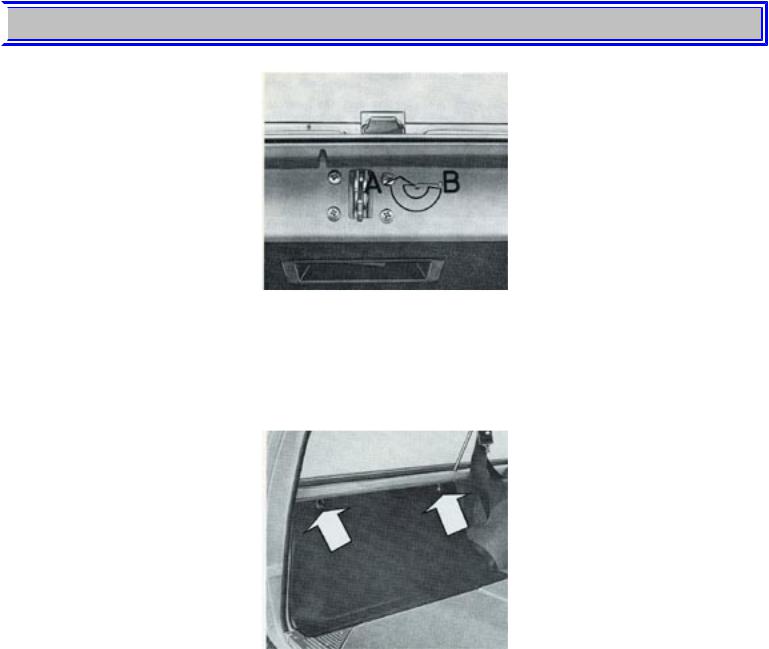
1974 Volvo 142 144 145
Cargo compartment 145 Station Wagon
The tailgate is opened from the outside by pushing down the lock plate. A gas spring and a lock arm hold the tailgate in the desired open position.
To shut the tailgate, the red-marked latch on the lock arm must be pressed upwards. The tailgate can be opened from the inside by pulling out the lock handle at the bottom. The tailgate is locked with the same key used for the doors.
 pg. 23 OPERATING INSTRUCTIONS
pg. 23 OPERATING INSTRUCTIONS
By turning a safety catch at the tailgate underside, it is possible to prevent it from being opened from the inside.
Turn the catch to left position (A) and close the gate, which now can opened from the outside only. The gate operates normally when the catch is in the right position (B).
Spare wheel 145 Station Wagon
The spare wheel is stored in a well to the left of the cargo compartment underneath the floor. To get at the wheel remove the two screws and lift the cover.
The jack is stored in this space.
http://new.volvocars.com/ownersdocs/1974/1974%20142%20144%20145/74142144145_01.htm (24 sur 32) [2013-03-14 11:43:46]
